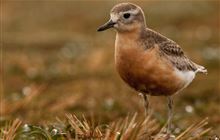Share our beaches this summer
Archived content: This media release was accurate on the date of publication.
Introduction
DOC and Gisborne District Council are reminding the public to be careful near New Zealand dotterel/tūturiwhatu and banded dotterel nesting sites on the East Coast this summer.Date: 18 December 2017

Step lightly near nesting sites this summer
Image: Mithuna Sothieson | DOC
DOC’s Biodiversity Ranger Jamie Quirk says most of the dotterel nesting sites in this region are in coastal areas, around rivers and streambeds from Hicks Bay to Te Wherowhero.
“As more people are outdoors this increases the chance of disturbances at these nesting sites from gravel extraction, visitors, users of off-road vehicles and dogs.”
“We want people to avoid these nesting sites where possible” says Mr Quirk.
Dotterels will nest anywhere from the high tide mark to the base of dunes or riverbeds. They lay two or three eggs in nests which are well camouflaged and therefore easily crushed by unsuspecting beach users.
You can help protect dotterel by keeping:
- below the high tide mark
- noise to a minimum and not getting too close
- to marked tracks and paths wherever possible
- dogs on a leash
- vehicles off beaches and sandspits.
Mr Quirk says these are small and effective measures to give these birds a fighting chance this breeding season. “DOC and the Gisborne District Council are working together in the recovery and long-term conservation of the dotterel.”
Dotterel pamphlets have been distributed to freedom campers, information centres and landowners.
Background
- The endangered New Zealand dotterel/tūturiwhatu was once widespread and common. Now there are only about 1,700 birds left, making dotterels more at risk than some species of kiwi.
- New Zealand dotterel/tūturiwhatu are shorebirds, usually found on sandy beaches and sandspits or feeding on tidal estuaries.
- New Zealand dotterel/tūturiwhatu are mostly pale grey on their backs, with off-white underparts which become flushed with rusty orange in winter and spring. They have a prominent head, large, dark-brown eyes and a strong black bill.
- Banded dotterel (Charadrius bicinctus) have a narrow black band on the neck and a wide chestnut band on the breast during the breeding season.
- Their camouflage colours make them difficult to see when standing still, but their habit of running quickly and pausing to feed makes them easy to identify. Their 'chip-chip' call is often heard before the birds are seen.
Contact
For media enquiries contact:
Jamie Quirk, Ranger, Biodiversity
DOC, Gisborne
Mobile: +64 27 432 4920
Sandy Gorringe, Water and Coastal Resources Officer
Gisborne District Council
Phone: +64 6 869 2479

